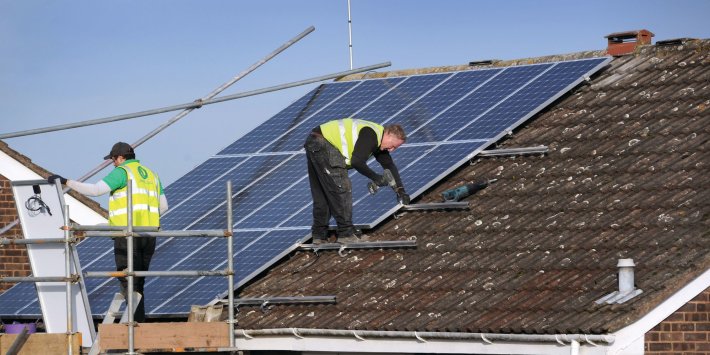Skilled labour shortage is stunting our green revolution

(Alamy)
Alexander Stafford MP
@Alex_Stafford
The story of the United Kingdom’s enthusiasm for green energy technologies is now a familiar one.
Wind, hydrogen, solar and hydro have been wholeheartedly taken up by Britons as we transition towards a low-carbon future and reap the benefits of home-grown energy. Of these clean, green machines, it is solar that has captured the hearts and minds of many of us.
Photovoltaic panels turn rooftops into generators and allow us to bring down energy bills, save the planet, and even make money by selling excess energy back into the grid. This has proved overwhelmingly popular with many homeowners and businesses, with nearly a million homes now bedecked in solar panels.
In fact, unlike wind turbines whose effect on our landscape is contentious, rooftop solar panels have become cool: nearly 70 per cent of prospective homeowners say that solar panels are a value-add to a property and concerns about the impact that solar farms can have on our landscapes mean rooftop solar is the most popular and accessible form of green energy. What’s more, for businesses who often use the most power in the daytime, solar panels offer an easy cut to running costs; and the government has laid out a raft of grants and support to make solar panels more accessible than ever.
It is now more expensive than ever to install solar panels
However, the outlook for solar panels is not as sunny as it might seem. While the demand for residential solar has soared, perhaps thanks to lockdown renovations and energy price shocks, the cost of solar installations does not seem to have followed the downward trend we have come to expect from these ever-developing green technologies.
China, which dominates the photovoltaic market, producing about 80 per cent of all solar panels, continues to cut the price of panels while boosting their efficiency; and the current price per kilowatt of photovoltaic panels is at an all-time low. The problem comes when the panels are installed. Government data shows that it is now more expensive than ever to install solar panels as we lack the skilled labour for this sort of work.
This is a bigger problem than it first might appear: the government has set an ambitious target of 70 gigawatts (GW) of solar capacity by 2035 – more than four times our current abilities. We need to be installing more solar, more often, in more places.
As long as we continue to lack the expertise and skilled labour needed to install solar panels, prices will remain high. Businesses and homeowners must be encouraged to take the leap into rooftop solar, finally making use of this underutilised real-estate.
A drive for rooftop solar will also be a driver for the labour we need to install these panels, perhaps encouraging those who might otherwise face a declining market in fossil fuels to make the switch, and reskill for our net-zero future.
If all new homes, factories and commercial premises were required to have solar capacity from the start, this would not only map a clear path to 2035 but also go a long way to build the baseline of skilled labour we will need to reach our low-carbon future.
The government’s support for solar and other green electricity generation cannot falter now, or we risk losing even the ability to achieve our targets: more solar panels installed means more labour to do that installing, bringing the costs down further for future projects, in a virtuous cycle.
The best way to do this is to ensure that all new buildings come with solar, and secure that easy double-win for our labour market and our carbon emissions.
No comments:
Post a Comment